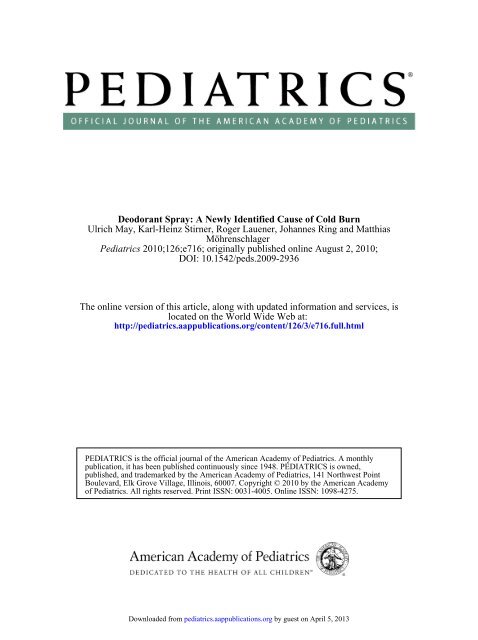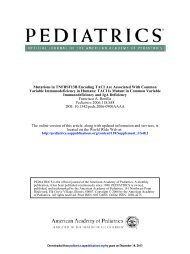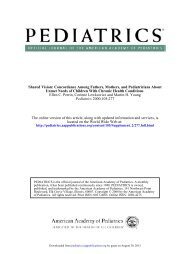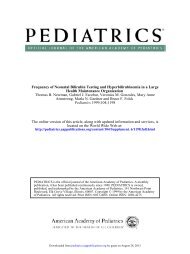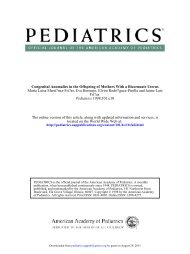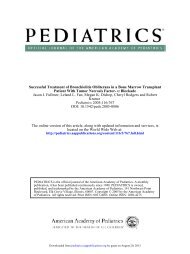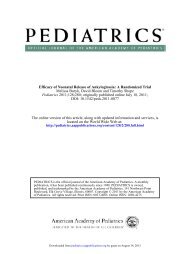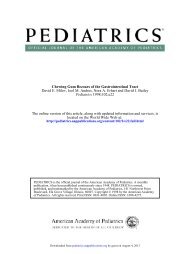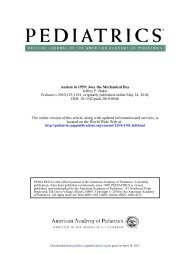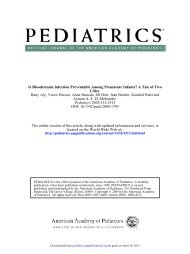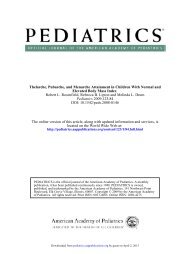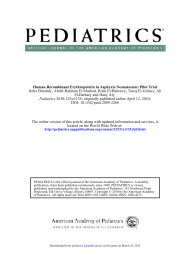Deodorant Spray: A Newly Identified Cause of Cold Burn ... - Pediatrics
Deodorant Spray: A Newly Identified Cause of Cold Burn ... - Pediatrics
Deodorant Spray: A Newly Identified Cause of Cold Burn ... - Pediatrics
Create successful ePaper yourself
Turn your PDF publications into a flip-book with our unique Google optimized e-Paper software.
<strong>Deodorant</strong> <strong>Spray</strong>: A <strong>Newly</strong> <strong>Identified</strong> <strong>Cause</strong> <strong>of</strong> <strong>Cold</strong> <strong>Burn</strong><br />
Ulrich May, Karl-Heinz Stirner, Roger Lauener, Johannes Ring and Matthias<br />
Möhrenschlager<br />
<strong>Pediatrics</strong> 2010;126;e716;<br />
originally published online August 2, 2010;<br />
DOI: 10.1542/peds.2009-2936<br />
The online version <strong>of</strong> this article, along with updated information and services, is<br />
located on the World Wide Web at:<br />
http://pediatrics.aappublications.org/content/126/3/e716.full.html<br />
PEDIATRICS is the <strong>of</strong>ficial journal <strong>of</strong> the American Academy <strong>of</strong> <strong>Pediatrics</strong>. A monthly<br />
publication, it has been published continuously since 1948. PEDIATRICS is owned,<br />
published, and trademarked by the American Academy <strong>of</strong> <strong>Pediatrics</strong>, 141 Northwest Point<br />
Boulevard, Elk Grove Village, Illinois, 60007. Copyright © 2010 by the American Academy<br />
<strong>of</strong> <strong>Pediatrics</strong>. All rights reserved. Print ISSN: 0031-4005. Online ISSN: 1098-4275.<br />
Downloaded from<br />
pediatrics.aappublications.org by guest on April 5, 2013
<strong>Deodorant</strong> <strong>Spray</strong>: A <strong>Newly</strong> <strong>Identified</strong> <strong>Cause</strong> <strong>of</strong><br />
<strong>Cold</strong> <strong>Burn</strong><br />
abstract<br />
Two patients encountered a first-degree cold burn after use <strong>of</strong> a deodorant<br />
spray. The spray-nozzle to skin-surface distance was 5 cm,<br />
and the spraying lasted 15 seconds. Under laboratory conditions, the<br />
deodorant in use was able to induce a decline in temperature <strong>of</strong> 60°C.<br />
These 2 cases highlight a little-known potential for skin damage by<br />
deodorant sprays if used improperly. <strong>Pediatrics</strong> 2010;126:e716–e718<br />
e716 MAY et al<br />
Downloaded from<br />
pediatrics.aappublications.org by guest on April 5, 2013<br />
AUTHORS: Ulrich May, MD, a Karl-Heinz Stirner, MD, b<br />
Roger Lauener, MD, b Johannes Ring, MD, PhD, c and<br />
Matthias Möhrenschlager, MDa Departments <strong>of</strong> aDermatology and Allergology and b<strong>Pediatrics</strong>, Allergieklinik, Hochgebirgsklinik/Christine Kühne-Center for<br />
Allergy Research and Education, Davos, Switzerland; and<br />
cDepartment <strong>of</strong> Dermatology and Allergy Biederstein, Technical<br />
University <strong>of</strong> Munich, Munich, Germany<br />
KEY WORDS<br />
frostbite, deodorant, propellant<br />
www.pediatrics.org/cgi/doi/10.1542/peds.2009-2936<br />
doi:10.1542/peds.2009-2936<br />
Accepted for publication May 6, 2010<br />
Address correspondence to Matthias Möhrenschlager, MD,<br />
Department <strong>of</strong> Dermatology and Allergology, Allergieklinik,<br />
Hochgebirgsklinik/Christine Kühne-Center for Allergy Research<br />
and Education, Herman-Burchard-Strasse 1, CH-7265 Davos,<br />
Switzerland. E-mail: matthias.moehrenschlager@hgk.ch<br />
PEDIATRICS (ISSN Numbers: Print, 0031-4005; Online, 1098-4275).<br />
Copyright © 2010 by the American Academy <strong>of</strong> <strong>Pediatrics</strong><br />
FINANCIAL DISCLOSURE: The authors have indicated they have<br />
no financial relationships relevant to this article to disclose.
Although deodorant sprays are applied<br />
many million times per day, cold<br />
burns after use <strong>of</strong> these devices have<br />
been rarely mentioned in the medical<br />
literature. 1–4 Here, we report a cluster<br />
<strong>of</strong> frostbite injuries caused by the improper<br />
use <strong>of</strong> an aerosol spray.<br />
CASE REPORTS<br />
A 14-year-old mixed-race (black/white)<br />
girl (patient 1) complained <strong>of</strong> localized<br />
pain and dark discoloration on her<br />
right hand 1 day after use <strong>of</strong> a deodorant<br />
spray (Rexona Girl Dance Energy<br />
[Unilever, Thayngen, Switzerland]) (Fig<br />
1) within a distance <strong>of</strong> 5cmfor15<br />
FIGURE 1<br />
Aerosol deodorant that was used within a few<br />
centimeters <strong>of</strong> the cutaneous surface.<br />
FIGURE 2<br />
First-degree frostbite on the dorsum <strong>of</strong> the hand after low-distance spraying <strong>of</strong> a deodorant for 15<br />
seconds (patient 1).<br />
FIGURE 3<br />
Temperature recorded by a contact thermometer (Fluke 51 II) according to time <strong>of</strong> exposure to the<br />
aerosol spray in use. The distance from the spray nozzle to the measuring point <strong>of</strong> the thermometer<br />
was 5 cm.<br />
seconds. The reason for this kind <strong>of</strong> exposure<br />
was, according to the patient, “a<br />
test <strong>of</strong> courage.” Except for atopic eczema<br />
and allergic asthma, her general<br />
medical history was uneventful. A<br />
healthy 45-year-old white friend <strong>of</strong> patient<br />
1 (patient 2), who did not believe the<br />
report given by patient 1, reapplied the<br />
deodorant spray at a similar distance<br />
and for a similar amount <strong>of</strong> time.<br />
Macroscopically, patients 1 and 2<br />
showed on the right dorsum <strong>of</strong> their<br />
hands a 4- 3-cm and a 3- 2-cm,<br />
respectively, erythematous macula<br />
with sharply confined margins representing<br />
first-degree frostbite (Fig 2).<br />
CASE REPORT<br />
The lesions were treated with nonadhesive<br />
dressings and topical corticosteroids<br />
at night and ultraviolet-ray<br />
protection during the day.<br />
As a sequela, a postinflammatory hypopigmentation<br />
(patient 1) and a hyperpigmentation<br />
(patient 2) became<br />
evident after several weeks <strong>of</strong> treatment.<br />
The patients were encouraged to<br />
continue with ultraviolet-ray protection<br />
for the next months.<br />
Figure 3 (created with Excel 2003<br />
[Micros<strong>of</strong>t Corp, Redmond, WA]) depicts<br />
the obtained temperature/<br />
exposure-time curve <strong>of</strong> the deodor-<br />
PEDIATRICS Volume 126, Number 3, September 2010 e717<br />
Downloaded from<br />
pediatrics.aappublications.org by guest on April 5, 2013
ant aerosol sprayed on a contact<br />
thermometer (Fluke 51 II [Fluke Corp,<br />
Everett, WA]) within a distance <strong>of</strong> 5<br />
cm and recorded for 15 seconds<br />
starting at a room temperature <strong>of</strong><br />
22.1°C. A decline in temperature <strong>of</strong><br />
60°C was demonstrated.<br />
DISCUSSION<br />
Frostbite is a disorder caused by the<br />
actual freezing <strong>of</strong> tissue beginning at<br />
temperatures <strong>of</strong> 2°C to 10°C. 1 Similar<br />
to burns caused by heat, the duration<br />
<strong>of</strong> exposure, affected region, immobility,<br />
and other factors may<br />
influence the amount <strong>of</strong> skin damage<br />
encountered. 5,6<br />
Low temperature-related effects can<br />
be induced, for example, by direct injury<br />
to the cell with intracellular ice<br />
formation, hypoxia caused by vessel<br />
constriction, and damage from inflammatory<br />
mediators. 7<br />
According to Amonton’s law, 8 the pressure<br />
(P) <strong>of</strong> a gas is proportional to the<br />
absolute temperature (T) for a fixed<br />
quantity <strong>of</strong> gas in a fixed volume:<br />
P1/T1 P2/T2. Therefore, a decline in<br />
the pressure <strong>of</strong> a gas (eg, by spraying<br />
the content <strong>of</strong> an aerosol can) results<br />
in a decline <strong>of</strong> temperature.<br />
Cooling effects may also arise from the<br />
low boiling points <strong>of</strong> propellants (eg,<br />
42.2°C for propane, 11.7°C for<br />
isobutane, and 0.6°C for butane).<br />
REFERENCES<br />
1. Petrone P, Kuncir EJ, Asensio JA. Surgical<br />
management and strategies in the treatment<br />
<strong>of</strong> hypothermia and cold injury. Emerg Med<br />
Clin North Am. 2003;21(4):1165–1178<br />
2. Lacour M, Le Coultre C. <strong>Spray</strong>-induced frostbite<br />
in a child: a new hazard with novel aerosol<br />
propellants. Pediatr Dermatol. 1991;8(3):<br />
207–209<br />
3. Elliott DC. Frostbite <strong>of</strong> the mouth: a case report.<br />
Mil Med. 1991;156(1):18–19<br />
e718 MAY et al<br />
Another possible cause for cutaneous<br />
affection may arise from hypertonic<br />
damage by the aerosol. 7<br />
In contrast to protein denaturation<br />
caused by heat burns, preserved dermal<br />
collagen prevents significant scarring<br />
after cold burns unless the freezing<br />
contact is particularly prolonged. 9<br />
In the literature, several reports deal<br />
with frostbite injuries after improper<br />
use <strong>of</strong> an aerosol spray by young persons.<br />
Lacour and Le Coultre2 discussed<br />
an 8-year-old boy who sustained a cold<br />
burn after spraying his forearm with a<br />
toilet air-freshener aerosol at close<br />
range for an unknown period <strong>of</strong> time.<br />
The aerosol in question used butane<br />
and propane as propellants. As in our<br />
case, the authors demonstrated that<br />
such a spray could induce a substantial<br />
decrease in temperature (40°C)<br />
when sprayed onto a toluene thermometer<br />
at close range.<br />
Elliott3 described a young boy who experienced<br />
a second-degree frostbite<br />
injury to his oral cavity, including the<br />
lower lip, hard palate, tongue, and buccal<br />
mucosa. This unusual injury occurred<br />
as a result <strong>of</strong> substance abuse<br />
via inhalation <strong>of</strong> an aerosolized propane<br />
propellant as a means <strong>of</strong> achieving<br />
euphoria.<br />
As an act “out <strong>of</strong> curiosity,” Camp et al4 reported the cases <strong>of</strong> 2 teenaged girls<br />
who sprayed their forearms and ankle<br />
4. Camp DF, Ateaque A, Dickson WA. Cryogenic<br />
burns from aerosol sprays: a report<br />
<strong>of</strong> two cases and review <strong>of</strong> the<br />
literature. Br J Plast Surg. 2003;56(8):<br />
815–817<br />
5. Möhrenschlager M, Ring J, Henkel V. Iatrogenic<br />
neonatal burns: more causes. Pediatr<br />
Dermatol. 2008;25(2):285–286<br />
6. Möhrenschlager M, Weigl LB, Haug S, et al.<br />
Iatrogenic burns by warming bottles in the<br />
Downloaded from<br />
pediatrics.aappublications.org by guest on April 5, 2013<br />
with a deodorant by holding the nozzle<br />
1 cm from the skin surface for a period<br />
<strong>of</strong> 20 to 30 seconds, which resulted<br />
in first- and second-degree<br />
frostbite injuries, respectively. The<br />
spray used by the girls contained butane<br />
and propane as propellants. In an<br />
experiment for which the same type <strong>of</strong><br />
deodorant was used, Camp et al<br />
sprayed the contents onto the bulb <strong>of</strong><br />
an alcohol thermometer from a distance<br />
<strong>of</strong> 1 cm and recorded the temperature<br />
reached. After spraying for 5<br />
seconds, the starting temperature<br />
(21°C) decreased to 0°C and declined<br />
further to 8°C, 13°C, and 15°C after<br />
10, 15, and 20 seconds <strong>of</strong> spraying,<br />
respectively. 3<br />
The spray in our case contained propane,<br />
isobutane, and butane as propellants.<br />
The producer informed us on a<br />
written warning on the spraying device<br />
that the product must be used from a<br />
minimum distance <strong>of</strong> 15 cm and that<br />
prolonged spraying should be avoided<br />
(Karin Zimmermann, Unilever, written<br />
communication Ref 13069903, 2009).<br />
CONCLUSIONS<br />
These cases highlight a little-known<br />
potential for skin damage from deodorant<br />
sprays when used improperly.<br />
However, in a majority <strong>of</strong> cases, the<br />
patients were obviously aware that<br />
such improper use would cause skin<br />
damage.<br />
neonatal period. J <strong>Burn</strong> Care Rehabil. 2003;<br />
24(1):52–55; discussion 49<br />
7. Dawber R. <strong>Cold</strong> kills! Clin Exp Dermatol. 1988;<br />
13(3):137–150<br />
8. Lide DR. CRC Handbook <strong>of</strong> Chemistry and<br />
Physics. 90th ed. Boca Raton, FL: Taylor &<br />
Francis; 2009<br />
9. Shepherd JP, Dawber RP. Wound healing and<br />
scarring after cryosurgery. Cryobiology.<br />
1984;21(2):157–169
<strong>Deodorant</strong> <strong>Spray</strong>: A <strong>Newly</strong> <strong>Identified</strong> <strong>Cause</strong> <strong>of</strong> <strong>Cold</strong> <strong>Burn</strong><br />
Ulrich May, Karl-Heinz Stirner, Roger Lauener, Johannes Ring and Matthias<br />
Möhrenschlager<br />
<strong>Pediatrics</strong> 2010;126;e716;<br />
originally published online August 2, 2010;<br />
DOI: 10.1542/peds.2009-2936<br />
Updated Information &<br />
Services<br />
Subspecialty Collections<br />
Permissions & Licensing<br />
Reprints<br />
including high resolution figures, can be found at:<br />
http://pediatrics.aappublications.org/content/126/3/e716.full.h<br />
tml<br />
This article, along with others on similar topics, appears in<br />
the following collection(s):<br />
Allergy & Dermatology<br />
http://pediatrics.aappublications.org/cgi/collection/allergy_an<br />
d_dermatology<br />
Information about reproducing this article in parts (figures,<br />
tables) or in its entirety can be found online at:<br />
http://pediatrics.aappublications.org/site/misc/Permissions.xht<br />
ml<br />
Information about ordering reprints can be found online:<br />
http://pediatrics.aappublications.org/site/misc/reprints.xhtml<br />
PEDIATRICS is the <strong>of</strong>ficial journal <strong>of</strong> the American Academy <strong>of</strong> <strong>Pediatrics</strong>. A monthly<br />
publication, it has been published continuously since 1948. PEDIATRICS is owned, published,<br />
and trademarked by the American Academy <strong>of</strong> <strong>Pediatrics</strong>, 141 Northwest Point Boulevard, Elk<br />
Grove Village, Illinois, 60007. Copyright © 2010 by the American Academy <strong>of</strong> <strong>Pediatrics</strong>. All<br />
rights reserved. Print ISSN: 0031-4005. Online ISSN: 1098-4275.<br />
Downloaded from<br />
pediatrics.aappublications.org by guest on April 5, 2013


